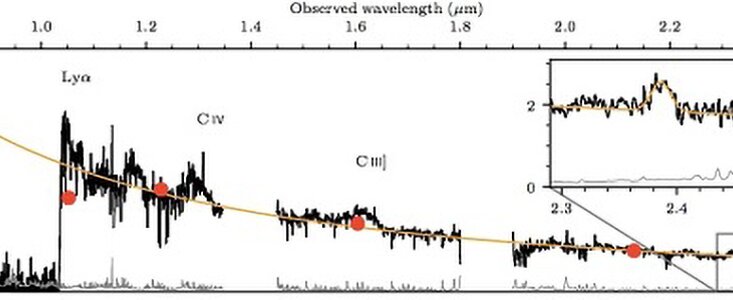Supermassive Black Hole is Ahead of its Time
6 Diciembre 2017
Observations reveal the mass of earliest known supermassive black hole which radiates from an era in the universe only 690 million years after the Big Bang. Researchers, using unique spectroscopic data from Gemini Near-Infrared Spectrograph (GNIRS) on Gemini North determined its mass at a whopping 800 million times the mass of our Sun.
The discovery of an extremely distant supermassive black hole, with a mass some 800 million times that of our Sun is causing astronomers to re-think our understanding of the early cosmos. Researchers report that this is the most distant giant black hole ever detected, and at this distance, our Universe was only about 5% of its current age, or about 690 million years after the Big Bang.
"Gathering all this mass in under 690 million years is an enormous challenge for theories of supermassive black hole growth," explains Eduardo Bañados, an astronomer at the Carnegie Institution for Science who led the international team of scientists.
The unexpected discovery is based on data amassed from observatories around the world. This includes key spectroscopic data from the Gemini Observatory that helped to determine the black hole’s enormous mass. The newly found black hole is voraciously devouring material at the center of a galaxy and releasing copious amounts of energy in what is called a quasar, short for quasi-stellar object.
According to Bañados, Gemini's capabilities on Hawaii's Maunakea made it uniquely qualified for these observations. "The air over Maunakea is exceptionally dry and still, which allows more of the infrared light to pass through and be captured by the large 8-meter Gemini mirror." Bañados adds that the Gemini Near-Infrared Spectrograph (GNIRS) went beyond what other instruments on other sites can do. "We dove deep into the infrared light spectrum at Gemini and probed the Magnesium lines," said Bañados. Magnesium lines are critical for determining a black hole’s mass, but for objects at this distance, the "redshifting" of the light makes them extremely difficult to capture from the surface of our planet due to absorption by atmospheric water vapor.
These results, including the quasar's discovery, are announced in the December 6th issue of the journal Nature.
The initial discovery of this quasar (given the identity J1342+0928) came to light thanks to the mining of three large area surveys: the DECam Legacy Survey (DECaLS) that is being carried out with the Dark Energy Camera on the National Science Foundation's Blanco 4-m telescope at the Cerro Tololo Inter-American Observatory in Chile, NASA’s Wide-field Infrared Survey Explorer (ALLWISE), and the United Kingdom Infrared Telescope Deep Sky Survey (UKIDSS) Large Area Survey.
"DECaLS was designed from the ground up as a public project, so it is wonderful to see the data enabling exciting discoveries that are pushing the boundaries of the known Universe," said Arjun Dey of the National Optical Astronomy Observatory (NOAO), one of the co-leads of the DECaLS survey.
"These observations further demonstrate Gemini's ability to probe the most distant objects in the Universe under the most challenging conditions," notes Chris Davis, Program Officer at NSF which is one of five international agencies that own and operate Gemini.
"Quasars are among the brightest and most-distant known celestial objects and are crucial to understanding the early Universe," added Bram Venemans of the Max Planck Institute for Astronomy in Germany. This result is an outcome of a long term effort that Bañados joined as a Ph. D. student at the Max Planck Institute for Astronomy in Fabian Walter's group.
Prior to this discovery, the record-holder for the furthest known quasar existed when the Universe was about 800 million years old. "Despite extensive searches, it took more than half a decade to catch a glimpse of something this far back in the history of the Universe," Bañados explained.
The discovery of a massive black hole so early in the Universe may provide key clues on conditions in the very early Universe, which allowed for black holes on the order of hundreds of thousands of solar masses to form. This is unlike black holes that form in the local Universe, which rarely exceed an initial mass of dozens of solar masses.
J1342+0928 existed during the epoch of reionization. This is a period when the early Universe emerged from its dark ages – the Universe emitted no light before gravity condensed matter into the first stars and galaxies.
An estimated 20 to 100 quasars as bright and distant as the quasar discovered by Bañados and his team are predicted to exist over the whole sky. The team plans to continue searching for similar quasars using Gemini and other large telescopes around the world.
"This finding shows that a process obviously existed in the early Universe to make this monster," Bañados adds. "What that process is? Well, that will keep theorists very busy!"
Contactos
Eduardo Bañados
Carnegie Institution for Science
Tel: 626-304-0236
Correo electrónico: ebanados@carnegiescience.edu
Arjun Dey
National Optical Astronomy Observatory
Tel: 520-318-8429
Correo electrónico: dey@noao.edu
Peter Michaud
Gemini Observatory
Tel: 808 974-2510
Cel: 808 936-6643
Correo electrónico: pmichaud@gemini.edu
Joan Najita
National Optical Astronomy Observatory
Tel: 520-318-8416
Correo electrónico: najita@noao.edu
About the Release
| Release No.: | gemini1711 |
| Nombre: | ULAS J1342+0928 |
| Facility: | Gemini North |
| Instruments: | GNIRS |
| Science data: | 2018Natur.553..473B |



